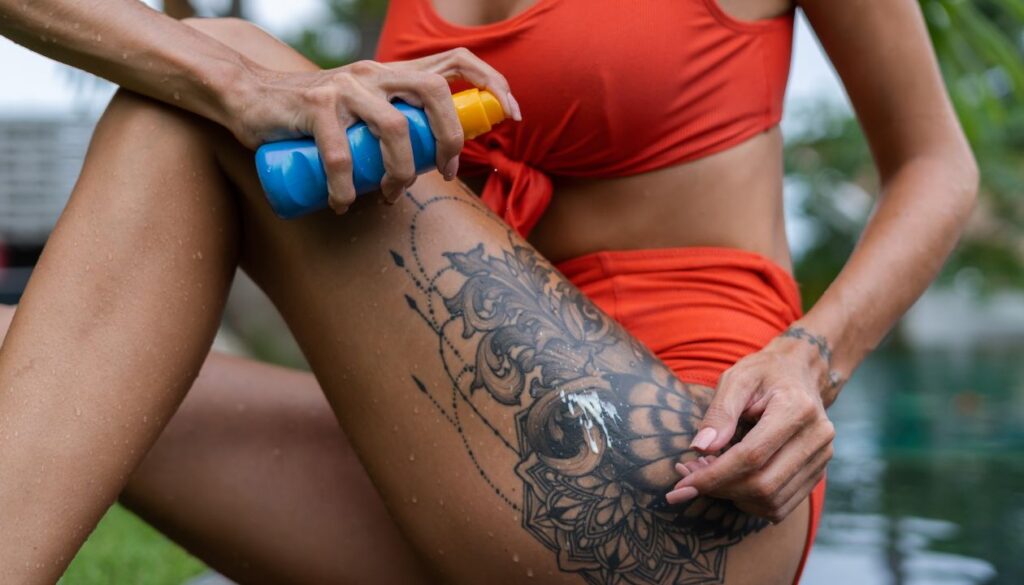Undergoing laser tattoo removal can be a transformative experience, but it comes with important responsibilities, especially when it comes to sun exposure. While soaking up the sun might feel great, UV rays can significantly hinder your healing process and impact your results.
If you’re not careful, sun exposure can lead to complications like hyperpigmentation and delayed healing, making it crucial to prioritize sun care during your treatment. Protecting your skin isn’t just a recommendation; it’s essential for achieving the best possible outcome.
This guide will cover essential strategies to safeguard your skin, helping you navigate the sunny days ahead while undergoing laser tattoo removal.
Understanding Laser Tattoo Removal
Laser tattoo removal uses concentrated beams of light to break down tattoo ink particles beneath the skin. Understanding this process helps you grasp why post-treatment care, especially sun protection, plays a crucial role in your recovery.
How Laser Treatments Work
Laser treatments utilize different wavelengths of light to target various ink colors. The laser energy shatters the ink particles into smaller fragments, allowing your body’s immune system to gradually remove them.
After treatment, the skin may experience temporary changes, such as redness, swelling, or blistering, as it begins the healing process. This phase is critical for achieving desired results.
Importance of Aftercare
Aftercare significantly impacts your healing and overall outcomes. Following treatment, your skin becomes sensitive and may be prone to complications, particularly from UV exposure.
Sunburn or tanning can result in hyperpigmentation and prolong healing. Implementing proper aftercare strategies is essential to protect your skin.
Sun Exposure After Tattoo Removal
Protecting your skin from sun exposure after laser tattoo removal is crucial for promoting healing and preventing complications. Understanding the risks and adhering to a proper timeline significantly impacts the results.
Risks of Sun Exposure
Exposing treated skin to sunlight exposes you to several risks. Direct sun exposure can lead to skin discoloration, resulting in hyperpigmentation or hypopigmentation, where areas become darker or lighter than your natural skin tone.
UV rays interfere with the healing process, potentially causing skin damage, blistering, and delayed recovery. Even mild sun exposure increases the likelihood of painful reddening and severe sunburn on sensitive areas.
Protecting your skin from these harmful effects becomes essential for optimal healing.
Proper Timeline for Sun Exposure
Adhering to a proper timeline for sun exposure supports better recovery outcomes. Avoid direct sunlight on the treated area for at least four weeks following laser tattoo removal.
During this time, consistently apply broad-spectrum sunscreen with an SPF of 30 or higher, even on cloudy days. Reapply sunscreen every two hours, especially after swimming or sweating.
After the initial four weeks, continue practicing sun safety; wear protective clothing and avoid peak sun hours between 10 AM and 4 PM to further safeguard your skin against UV radiation.
Best Practices for Sun Protection
Protecting your skin during the laser tattoo removal process is essential for optimal healing and results. Implementing effective sun protection strategies minimizes the risk of complications and promotes skin health.
Choosing the Right Sunscreen
Choosing the right sunscreen is crucial for effective protection. Look for a broad-spectrum sunscreen labeled with an SPF of at least 30.
This level provides adequate defense against the sun’s harmful UVA and UVB rays. Generously apply sunscreen on treated areas, even on cloudy days when UV rays can still penetrate through clouds.
Reapply sunscreen every two hours, or every hour if you’re swimming or sweating. Consider formulas designed for sensitive skin, as they often contain fewer irritants, ensuring comfortable application on recently treated areas.
Additional Protective Measures
Adopting additional protective measures further enhances your skin’s safety. Wear protective clothing, such as long-sleeved shirts and wide-brimmed hats, when outdoors. This physical barrier shields your skin from direct sunlight.
Use umbrellas or seek shaded areas, especially during peak sun hours from 10 AM to 4 PM. Additionally, limit time spent in direct sunlight to reduce the risk of sunburn and skin damage. Following these guidelines helps preserve the integrity of your skin and supports healing during the tattoo removal process.
Skin Care Post-Treatment
Post-treatment skin requires careful attention to ensure optimal healing and recovery. Adhering to proper skin care practices significantly contributes to the overall results of your tattoo removal process.
Gentle Cleansing and Moisturizing
Cleanse the treated area gently using a fragrance-free, mild cleanser. Avoid scrubbing the skin to prevent irritation during the sensitive healing phase. Pat the area dry with a clean towel.
Moisturize daily with products containing hyaluronic acid and ceramides, which help maintain hydration and support the skin’s barrier. Choose fragrance-free options to minimize the risk of irritation and allow your skin to recover effectively.
Follow-Up Care Tips
Apply a broad-spectrum sunscreen with an SPF of 30 or higher to the treated area for at least four weeks post-treatment. Reapply sunscreen every two hours, especially after swimming or sweating.
Wear protective clothing like long sleeves and wide-brimmed hats to shield your skin from direct sunlight. Limit sun exposure during peak hours, typically between 10 AM and 4 PM, to further reduce potential damage.
If you notice any unusual changes, such as increased redness or blistering, consult with your healthcare provider for appropriate guidance.
Monitoring Your Skin Health
Monitoring your skin health during the laser tattoo removal process is crucial for ensuring optimal recovery. You should stay vigilant about any changes in the treated area.
Signs to Watch For
Watch for the following signs that may indicate complications during the healing process:
- Redness and Swelling: Mild redness and swelling are normal, but persistent or increasing inflammation may signal an issue.
- Blistering: Blisters that form should be monitored closely; if they appear large or don’t heal, consult your provider.
- Discoloration: Light or dark patches that develop in the treated area can indicate hyperpigmentation, a potential complication from sun exposure.
- Pain or Itching: Severe or increased pain, along with significant itching, might suggest an allergic reaction or infection.
- Delayed Healing: If the skin doesn’t show signs of healing within a reasonable timeframe, check in with your healthcare professional.
When to Seek Professional Advice
- Persistent Symptoms: Contact your provider if redness, swelling, or pain continues beyond a week.
- Severe Blistering: If blisters are excessively painful or show signs of infection, such as pus, immediate consultation is necessary.
- Skin Changes: Any notable change in skin color or texture warrants a professional evaluation.
- New Symptoms: New symptoms that arise, including fever or chills, may indicate an infection needing prompt attention.
- Skin Care Concerns: Discuss any uncertainty about your aftercare routine or skin condition with your healthcare provider to ensure proper recovery.
Conclusion
Taking care of your skin during laser tattoo removal is crucial for achieving the best results. By prioritizing sun protection you can significantly reduce the risk of complications and promote a smoother recovery.
Remember to avoid direct sunlight for at least four weeks after treatment and consistently apply a broad-spectrum sunscreen.
Incorporating protective clothing and seeking shade during peak hours can further safeguard your skin. Stay vigilant about any changes in the treated area and consult your healthcare provider if you notice anything unusual.
Following these sun care tips will help you navigate the tattoo removal process more effectively and enhance your overall skin health.
Frequently Asked Questions
How does sun exposure affect laser tattoo removal?
Sun exposure during laser tattoo removal can lead to complications like hyperpigmentation and delayed healing. UV rays can damage sensitive skin after treatment, increasing the risk of discoloration and blistering. Protecting the area from the sun is crucial for optimal recovery and results.
How long should I avoid the sun after tattoo removal?
It’s recommended to avoid direct sun exposure on the treated area for at least four weeks following laser tattoo removal. This helps protect the healing skin and prevents complications such as discoloration and blistering.
What type of sunscreen should I use after laser tattoo removal?
Use a broad-spectrum sunscreen with an SPF of 30 or higher after laser tattoo removal. Ensure to apply it generously and reapply every two hours, especially after swimming or sweating, to protect your sensitive skin.
Can I wear sunscreen immediately after the procedure?
Yes, you can apply sunscreen immediately after the procedure, but ensure that the skin is clean and dry first. This will help protect the treated area from UV damage during the healing process.
What are the best practices for sun protection during tattoo removal?
Best practices include using a broad-spectrum sunscreen with SPF 30+, wearing protective clothing, using wide-brimmed hats, and seeking shade during peak sun hours. These measures will enhance skin safety and support healing throughout the tattoo removal process.
How do I know if there’s a complication after treatment?
Monitor for signs of complications such as persistent redness, swelling, blistering, or unusual pain and itching. If symptoms persist or worsen, it’s important to consult your healthcare provider for advice and possible treatment adjustments.
Can I expose my tattoo to the sun if it’s healed?
Once your tattoo is completely healed, you can expose it to the sun, but it’s essential to continue using sunscreen and protective measures to prevent long-term skin discoloration and damage even on healed tattoos.
Love It or Lose It: Protect Your Skin During Tattoo Removal
Laser tattoo removal is a process, and aftercare is key. At Love It or Lose It, we’ll provide guidance on protecting your skin, including essential sun care tips to help support your results.
Have questions about how to keep your skin in top condition? Reach out today and let’s make sure your tattoo removal journey goes as smoothly as possible!


